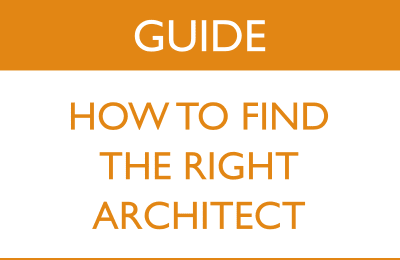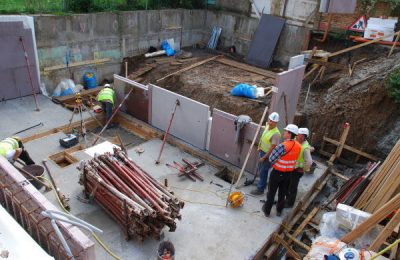
At Rare Space, we specialise in selling homes designed by an architect or designed by you. For a custom build home you might not know exactly what you need to do, or who to hire, especially if you’ve never done a self-build or custom build before. It’s important to find someone that shares your same vision, and that you work well with to help you realise your build.
Here are our top 5 tips to help you find an architect to help you create the home that suits you and your lifestyle.
Tip one: How to be a good client
First, understand what’s important to you and make sure that you hire an architect in line with your personality and your ambition.
Second, be clear in your brief and don’t change your mind. This is the biggest issue of any project. It’s better to take much longer in the planning stage and get it right on paper so that once you’re in the construction phase, you aren’t making costly modifications. Changing your mind not only opens you up to budget increases, it extends the time of the project and demoralises the project team.
Third, understand your role in the project. If you are going to act as project manager, then you need to make sure you are organised, you have everything you need, and know what you’re doing. It’s not fair to expect professionals to enlighten you with project management education.
Finally, enjoy the process. Doing a custom build or self-build is a great experience, but small things will go wrong, budgets will be stretched, and projects may be delayed. In the end all will be worth it and it’s important to keep focused. You are the leader of the team and you need to keep momentum and motivation high. Celebrate the successes and don’t get too stressed about the lows.
Tip two: Pick the right size team for the job

Most of the architects that we know follow a similar path in their career. When they’re young, they join a large firm. Shortly after that they decide to set out on their own. It’s likely that their first few commissions will be on renovations or extensions from friends or family. Then, they’ll pick up more domestic commissions from friends of friends.
If some of their projects do really well and they win some awards, they will likely pick up more work that way. Many will enter competitions for public projects – often commissioned by local authorities. They then start doing work for developers on larger commercial projects.
There’s a balance to be had, but we would always recommend that you pick a firm which is at the right stage of growth to give you the attention you need. Too big a firm, and your job will get lost in the workload, too small and the firm may not have the experience to properly carry it out.
Generally, if it’s a simple fit out, architects that are a small practice will be able to cope with this. If it’s a fit out that’s particularly complicated – either through the construction element or the design side – it would be better to go with a practice that is more experienced and has a wider network of contacts as you may need a larger team.
Tip three: Don’t expect architects to do or know everything
One common misconception is that once you employ an architect, you will not need any other professionals. Unfortunately this is unlikely to be the case.
At a minimum, most projects will require a structural engineer. However, increasing complexity will mean that the professional team might have to include planning consultants, cost consultants and M&E consultants (plumbing and electrics). New builds may also have to have other specialists, such as fire or drainage consultants.
We often hear complaints of a lack of communication between architect and client. Clients sometimes expect architects to not only be the designers of the project, but also to teach them what they need to be doing next. Unless you are specifically employing your architects to be project manager, it would be unfair to expect them to tell you when to order tiles, how many, or what type.
The same is true of all of the other ‘client supply’ items. You must understand that it is your responsibility to manage the programme and figure out what you need to do to enable your project to stick within your budget and time constraints.
Tip four: There is a tension between design and buildability
 Upside down house in Bispingen, photo by Axel Hindemith
Upside down house in Bispingen, photo by Axel Hindemith
Great architects want to build great projects. They put good design at the heart of what they do. Your project is their next piece of branding, so it’s of little surprise that good architects will be more attracted to doing interesting projects for clients who value design.
However, this can be a source of tension. Good design is often more difficult and more expensive to build. It takes more time and more consideration not only from the architect, but also from the rest of the professional team. Builders want to just get on with the job as they may have done it in the past a hundred times, whereas an architect will want to consider just how the edge of the window aligns with the staircase or how the floor meets the wall.
Often, the devil is in the details and that’s where good design lies. Sometimes inexperienced architects may draw something which they haven’t actually worked out how to build, and they may be assuming that they will be able to source a piece of kit which can do that job. If you’re on a tight budget, it’s important to quiz the architect on those items. There’s a saying amongst builders: “it’s better to build with things you can buy, than things you can order”.
As a client, you will need to work out what is more important to you and be clear about that from the outset. If you want a job done simply and quickly and aren’t so bothered about the finer details, you should consider the architect that you employ, or whether you need one at all by going direct to a builder. If a highly considered design is of upmost importance, then you will need to find a contractor who understands that and has an excellent network of specialist suppliers to find that unique product to enable the architect’s drawings to be built.
Tip five: Do I need an architect?
This will very much depend on what kind of home you want to create. As a general rule, the more complex the project and the more ‘out of the ordinary’, the more likely an architect will be needed.
If you are planning a simple straight forward layout and build, you have the choice to work directly with your builder (using a ‘design and build’ contract), working with a specialist firm (people who do nothing else apart from bathroom fitouts, say), an architectural technician, or even just a chartered surveyor.
If you are buying a custom build home, planning permission will have already been granted, and you don’t technically need an architect. However, it would be wise to use one unless you are using one of the specialist firms. The downside of using anyone other than an architect is that they will apply a standard approach to your build. If you want to do something a bit special, you would be better off with the assistance of an architect.
Have more questions? Leave us a comment below!




Thank you for telling me that I should know and understand what is important to me before I hire an architect who is in line with my personality, ambition, and goals. It is going to be my first-time choosing to have a custom-built house rather than buying something that is already built so I’m hoping that I don’t screw it up. I will finalize every idea I have so I won’t change my mind sooner or later once I have decided to hire an expert in architectural services.
That’s great that you will be custom building your house! Good luck with the process, it’s definitely good to have a professional on your side.